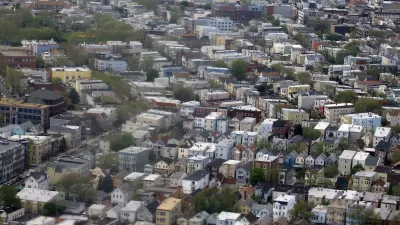What to do with 200 vacant, industrial acres bordering S.F. Bay in Newark, CA is no easy task for city planners who face activists, including environmentalists, skeptical of any development, let alone one of higher density.
Braden Reddall and Rory Carroll examine the challenges faces the small, East Bay city of Newark as they plan the next phase for the massive, bay-side redevelopment known as the Dumbarton Transit-Oriented Development. The project is located adjacent to a rail station for the proposed Dumbarton commuter railroad crossing of the lower San Francisco Bay, connecting to Redwood City in southern San Mateo county in the West Bay (also known as the Peninsula).
The city is keen on meeting the intent of state law SB 375 - reducing transportation-generated greenhouse gas emissions by a variety of measures, particularly smart growth land use strategies that reduce vehicle trips. "With an eye on the state's new land-use laws to cut carbon output, Newark's city council just voted to convert 200 acres owned largely by chemical companies into a development that should set the trend for a state bent on decarbonising its economy, the world's ninth largest.
The marshes could be turned over to birds, satisfying environmentalists, or paved over with single family homes, like most of the Bay Area. "We're trying to be a post-suburban community," said Terrence Grindall, Newark's community development director. "And then there are the environmentalists and homeowners who do not want the last patches of undeveloped land clogged up with dense housing that's bad for wildlife and property values.
"I wouldn't want to live in something like this. People are going to be packed in like sardines," said Margaret Lewis, a member of the Citizens Committee to Complete the Refuge, a group dedicated to protecting the San Francisco Bay's remaining wetlands, which opposes the Newark project.
According to city plans, "higher densities of residential development-such as condos-would be located within a quarter-mile radius of the transit station, medium densities-such as townhomes-are located slightly further, and single family dwellings are located farthest from the station."
"Having to battle environmentalists for more sustainable projects is not what developers had in mind."
"There's an identity crisis in the environmental movement," said Peter Calthorpe, an urban planner who designed models for the state's regional planners. Environmentalists in the 1970s were the vanguard opposing sprawl. And now, he says, they provide cover for anyone who opposes dense urban housing.
FULL STORY: California planning low-carbon oasis where cars aren't king

Planetizen Federal Action Tracker
A weekly monitor of how Trump’s orders and actions are impacting planners and planning in America.

Congressman Proposes Bill to Rename DC Metro “Trump Train”
The Make Autorail Great Again Act would withhold federal funding to the system until the Washington Metropolitan Area Transit Authority (WMATA), rebrands as the Washington Metropolitan Authority for Greater Access (WMAGA).

The Simple Legislative Tool Transforming Vacant Downtowns
In California, Michigan and Georgia, an easy win is bringing dollars — and delight — back to city centers.

The States Losing Rural Delivery Rooms at an Alarming Pace
In some states, as few as 9% of rural hospitals still deliver babies. As a result, rising pre-term births, no adequate pre-term care and harrowing close calls are a growing reality.

The Small South Asian Republic Going all in on EVs
Thanks to one simple policy change less than five years ago, 65% of new cars in this Himalayan country are now electric.

DC Backpedals on Bike Lane Protection, Swaps Barriers for Paint
Citing aesthetic concerns, the city is removing the concrete barriers and flexposts that once separated Arizona Avenue cyclists from motor vehicles.
Urban Design for Planners 1: Software Tools
This six-course series explores essential urban design concepts using open source software and equips planners with the tools they need to participate fully in the urban design process.
Planning for Universal Design
Learn the tools for implementing Universal Design in planning regulations.
Smith Gee Studio
City of Charlotte
City of Camden Redevelopment Agency
City of Astoria
Transportation Research & Education Center (TREC) at Portland State University
US High Speed Rail Association
City of Camden Redevelopment Agency
Municipality of Princeton (NJ)




























